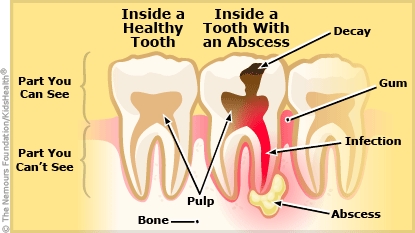After Treatment for a Dental Abscess: How to Care for Your Child
A dental abscess, or tooth abscess, is an infection that leads to a buildup of pus inside a tooth. It happens when bacteria (a type of germ) gets into the tooth through a cavity or broken tooth. Your child was treated by your dentist for a dental abscess. Use these instructions to care for your child and to help them develop the dental habits that can prevent another abscess.


-
To treat the abscess, the dentist either drained the abscess, did a root canal, or pulled the tooth. Ask your dentist:
-
When it's OK for your child to eat and if they need to have a special diet or avoid any foods or drinks.
-
If it's OK for your child to take acetaminophen (such as Tylenol® or a store brand) OR ibuprofen (such as Advil®, Motrin®, or a store brand) for pain. If it is, follow the package directions for how much to give and how often.
-
Whether your child should do a saltwater rinse and spit (8 ounces of water mixed with ½ teaspoon of salt).
-
If any medicines were prescribed, be sure your child takes them as instructed.
-
Follow up as instructed by your dentist.
Help your child develop good dental habits to prevent tooth decay and another abscess:
Brushing and Flossing
-
For children under 3 years old: Help your child brush twice a day for 2 minutes with a soft toothbrush with a smear (the size of a grain of rice) of fluoride toothpaste.
-
For children 3 years old and older: Help your child brush twice a day for 2 minutes with a pea-size amount of fluoride toothpaste. Teach your child to spit the toothpaste out. When your child has teeth that touch, help them floss once a day.
-
Children 10 years and older usually can brush and floss on their own. Help them remember to brush twice a day and floss once a day.
Other Reminders
-
Follow your dentist's instructions about fluoride supplements, treatments, and mouthwash.
-
By their first birthday, children should not drink from bottles and use a cup instead.
-
Do not give juice to babies younger than 12 months old. If you do give juice after that, give less than 4 ounces a day to toddlers, less than 6 ounces a day to kids ages 4–6, and less than 8 ounces to kids over age 7. Always use 100% fruit juice, serve it in a cup (not in a bottle), and give it at mealtimes only.
-
Don't let your child go to bed with a bottle or sippy cup with milk or juice in it. Don't let them sip on a bottle or sippy cup throughout the day with anything but water in it.
-
Limit sugar-sweetened beverages (like soda, juice drinks, sports drinks, and flavored milks) and sugary snacks (especially sticky candy). If your child does have these, serve at mealtimes, and have them brush their teeth after.
-
Take your child to the dentist twice a year, or more if recommended by your dentist.

Your child:
-
has worsening pain or swelling around the tooth
-
has pain that isn't controlled by the pain medicines
-
gets swelling of the face, jaw, or neck
-
has trouble chewing or swallowing
-
is coughing or throwing up
-
has a new or higher fever or a fever longer than 2 days after seeing the dentist

Your child:

How do dentists treat a dental abscess? To treat an abscess, dentists can:
-
Drain the abscess by putting a small needle into the area, taking out the pus, and cleaning the area where the infection was.
-
Do a root canal. To do a root canal, dentists first give medicine to make the area numb (not feel pain). Some who are specially trained to do so also might give kids medicine to make them very sleepy and unaware of the procedure. Then they drill into the tooth, remove the infected area, drain out any pus, and fill and seal the tooth. If needed, they can put a crown (tooth-shaped cap) on top of the tooth that's left.
-
Pull the tooth, especially if it is a primary ("baby") tooth, because the adult tooth will grow in to replace it.
What problems can happen from a dental abscess? An untreated dental abscess can lead to:
-
loss of the tooth
-
infection of the areas around the tooth, such as the sinuses, jaw, head, and neck
-
infection in the blood that can lead to sepsis (when the immune system goes into overdrive when fighting an infection and attacks the body's own organs and tissues)